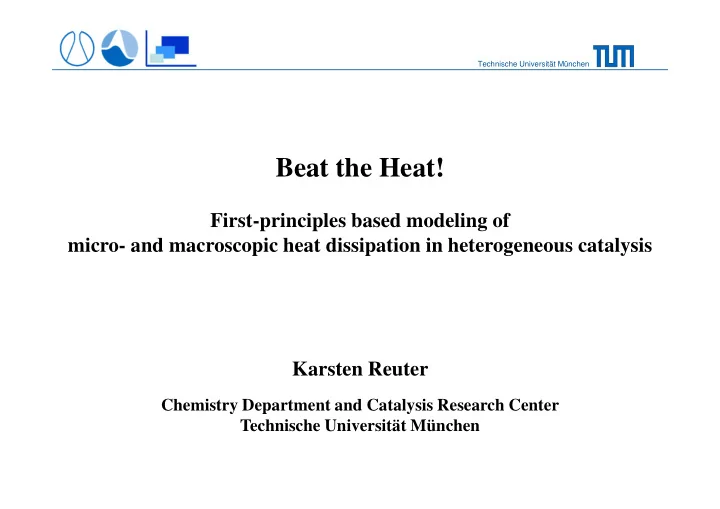

Technische Universität München Beat the Heat! First-principles based modeling of micro- and macroscopic heat dissipation in heterogeneous catalysis Karsten Reuter Chemistry Department and Catalysis Research Center Technische Universität München
Challenges across the scales Self-consistent coupling to reactive flow field and appropriate heat balance Surface chemistry: adsorption, diffusion, reaction, desorption Accurate (first-principles) energetics Quantitative transient and of individual elementary processes steady-state surface kinetics
I. Integrating first-principles microkinetics into fluid dynamical simulations: Macroscopic heat dissipation
Chemical kinetics: Tackling rare-event time scales k B → A k A → B � E A → B � E B → A kinetic Transition State Monte Carlo Theory TS N Z k T TS ( → ) i j = B k B → i j h Z B i A − ∆ E → exp i j = Γ Molecular � k T A t Dynamics B ( ) dP t ∑ ∑ ( ) ( ) = − + i k P t k P t → → i j i j i j dt j j First-principles kinetic Monte Carlo simulations for heterogeneous catalysis: Concepts, status and frontiers K. Reuter, in “Modeling Heterogeneous Catalytic Reactions: From the Molecular Process to the Technical System”, (Ed.) O. Deutschmann, Wiley-VCH, Weinheim (2011). http://www.th4.ch.tum.de
Surface structure and composition in the reactive environment CO oxidation at RuO 2 (110) p O (atm) 600 K 2 10 -15 10 -10 10 -5 10 +5 1 10 5 CO br /CO cus CO br /CO cus p CO (atm) T = 600 K , p O = 1 atm, p CO = 7 atm 2 1 CO br /- 10 -5 O br /O cus O br / - O br /O cus K. Reuter, D. Frenkel and M. Scheffler, Phys. Rev. Lett. 93, 116105 (2004)
Steady-state and transient parameter-free turnover frequencies TPR 350 K p CO (10 -9 atm) 0.0 1.0 2.0 3.0 TOF CO2 (10 12 mol/cm 2 s) 6 p O2 = 10 -10 atm Exp. x x x 4 x x x x x x 2 Theory x x x x x x x xx x 0 M. Rieger, J. Rogal, and K. Reuter, K. Reuter and M. Scheffler, Phys. Rev. Lett. 100, 016105 (2008) Phys. Rev. B 73, 045433 (2006)
Macroscopic regime: Heat and mass transfer Computational Fluid Dynamics: T , p CO , p O 2 Stationary stagnation point flow p CO p O 2 p CO 2 T p Chemical source terms from 1p-kMC S. Matera and K. Reuter, Phys. Rev. B 82, 085446 (2010)
Adiabatic limit: Surface heating p O2 = 0.3 atm u inl = 1 cm/sec no heat flux S. Matera and K. Reuter, Catal. Lett. 133,156 (2009)
Isothermal limit: Mass transfer limitations T = 600 K p O2 = 0.3 atm u inl = 1 cm/sec T = const S. Matera and K. Reuter, Catal. Lett. 133, 156 (2009)
Lateral channel flow: Surface heating and spatial variations p O2 = 0.3 atm p CO = 0.6 atm u inl = 10 cm/sec S. Matera and K. Reuter, in preparation
II. Heat dissipation: More than just macroscale warm-up?!
Really Markov ?! ? Showcase O 2 /Pd(100): 2.6eV adsorption energy released ! (at GGA/PBE level)
e-h pair excitation: Time-dependent perturbation theory M. Timmer and P. Kratzer, Phys. Rev. B 79, 165407 (2009) J. Meyer and K. Reuter, New J. Phys. 13, 085010 (2011)
Phonon energy sinks „from the shelf“
Exploiting locality: Elastic vs. chemical forces - forces (eV/Å) Adsorbate-induced 1.0 forces 0.1 very short ranged ! 0.01
QM/Me embedding - + Large-scale MM MD … with additional QM-force contributions DFT-parametrized MEAM DFT GGA/PBE 50x50x50 Pd atoms 6x3x4 (or 8x3x4) slabs LAMMPS CASTEP S.J. Clark et al., Z. Kristallogr. 220, 567 (2005) S. J. Plimpton, J. Comp. Phys. 117, 1 (1995)
Forget Markov: Hot adatoms are alive! pA ( ( ( ) ( ) ) ) ~ = = = = k S T uc � π π π π mk T 2 B Z=1.5 Å J. Meyer and K. Reuter, submitted
Beaten by the heat… Detailed account of heat dissipation at macroscopic and microscopic level essential to reach predictive-quality in comprehensive (nano!) catalysis modeling MMM Jörg Meyer Sebastian Matera
Recommend
More recommend